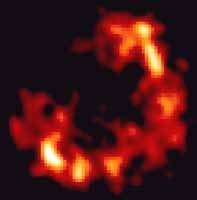| . |  |
. |
 Manchester - December 8, 1999 - British radio astronomers have used a telescope the size of the earth to peer into the heart of a nearby galaxy where they have found the scattered remains of stars that have torn themselves apart in catastrophic explosions.
Manchester - December 8, 1999 - British radio astronomers have used a telescope the size of the earth to peer into the heart of a nearby galaxy where they have found the scattered remains of stars that have torn themselves apart in catastrophic explosions.These remnants contain the heavy elements which are the building blocks for life itself and, for the first time, astronomers can now study in detail the mechanism by which this material is introduced and scattered into space. Their highly detailed images, from one of the largest radio astronomy experiments ever performed, will be presented at the December 10th meeting of the Royal Astronomical Society. The astronomers are led by Dr. Alan Pedlar and Dr. Tom Muxlow of the Jodrell Bank Observatory (University of Manchester), and Dr. Karen Wills of Sheffield University. Using a collection of 20 radio telescopes spaced right around the earth, the team have produced an image of unprecedented detail of the galaxy known as M82. They found bright remnants of exploding stars and, comparing them with images taken many years ago, have found these shells of gas are expanding at up to 20,000 km every second. The youngest object they found to be only 35 years old. The technique of combining the signals from radio telescopes spaced across continents results in very detailed pictures of the sky. The British astronomers have performed their observations with one of the largest ever collections of telescopes. It's as if they had a telescope 12,000 km across.
The astronomer's target was the nearby starburst galaxy M82. Starburst galaxies, containing many billions of stars, are disturbed and are undergoing a rapid phase of star creation. Most new stars are quite small and live a long time like our local example, the Sun. But a small number of new stars are huge and evolve very rapidly -- living for only a few million years or so. As Dr. Phil Diamond, director of the MERLIN/VLBI National Facility put it "These giant stars live fast and die young". So, paradoxically, the signature of such star-birth is the explosive death of massive stars. When such large stars die, they do so in spectacular fashion. They blow themselves apart in a titanic explosion called a 'supernova'. The remnants of these supernovae are often expanding shell-like clouds of gas shining brightly in radio waves. Understanding such supernova remnants in regions where stars are being made is particularly important as it is thought that most galaxies, including our own, passed through this phase many billions of years ago when the universe was young. However, the supernova remnants cannot easily be seen in visible light -- even with the Hubble space telescope -- because starburst galaxies contain a lot of obscuring dust. But, as Dr. Tom Muxlow explained, "Radio waves are unaffected by this dust and we are able to look right into the violent centre of the galaxy". The spectacular deaths of the massive stars in the centre of Messier 82, can be used to gain insights into the whole starburst phenomenon. In this galaxy astronomers have seen, for the first time, the detailed evolution of the expanding fireball from a supernova explosion. And these distant and violent events have a strange twist in their tail. Dr. Karen Wills explained; "It is the death-throes of these massive stars which create the heavy elements from which life is made". All the material which makes up the Earth, the rocky planets and moons in our Solar System and indeed, our own bodies, was made in massive stars and scattered by such explosions in the early history of the Milky Way. These latest results will be presented at the December 10th meeting of the Royal Astronomical Society by PhD student, and newest member of the team, Andy McDonald. This project also marks an important technical landmark in VLBI, in that this is the first time that the tape-recorded signals from 20 telescopes across the world have been simultaneously correlated. This was achieved by the the NRAO VLBA correlator facility in Socorro, New Mexico, USA.
TERRADAILY.COM
|
| |||||||||
| The content herein, unless otherwise known to be public domain, are Copyright 1995-2016 - Space Media Network. All websites are published in Australia and are solely subject to Australian law and governed by Fair Use principals for news reporting and research purposes. AFP, UPI and IANS news wire stories are copyright Agence France-Presse, United Press International and Indo-Asia News Service. ESA news reports are copyright European Space Agency. All NASA sourced material is public domain. Additional copyrights may apply in whole or part to other bona fide parties. Advertising does not imply endorsement, agreement or approval of any opinions, statements or information provided by Space Media Network on any Web page published or hosted by Space Media Network. Privacy Statement All images and articles appearing on Space Media Network have been edited or digitally altered in some way. Any requests to remove copyright material will be acted upon in a timely and appropriate manner. Any attempt to extort money from Space Media Network will be ignored and reported to Australian Law Enforcement Agencies as a potential case of financial fraud involving the use of a telephonic carriage device or postal service. |